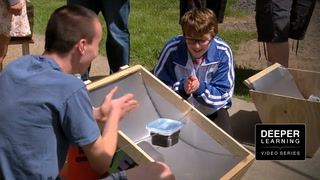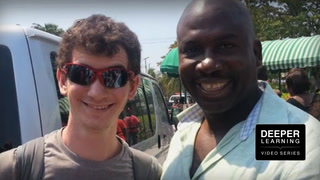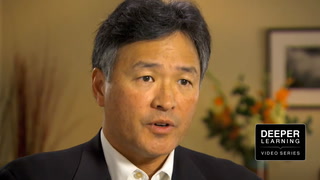Critical Friends: Looking at Student Work Transcript
[00:00]
Teacher: Here you’re gonna choose one historical example [cross talk 00:09].
Narrator: Schools and teachers have to become part of a process that is constantly reflecting and learning from each other in order to improve their curriculum.
Teacher: Looking back, how could I have communicated that better?
Teacher: There has to be some other way to assess it.
Teacher: That’s a skill that if our kids got, it would help them beyond.
Narrator: Our teachers engage in protocols that allow them to get together as a group in a way that lowers teachers’ defenses to give each other feedback and to help calibrate their understanding of what excellent student work is. One of those protocols is Critical Friends which these teachers engage in regularly.
Teacher: We offer likes and wonders and next steps and general critique on each other’s work.
Teacher: When I have Critical Friends, I can’t wait. I know that I’m gonna get ideas that I didn’t think of. I get excited about that. I don’t feel defensive about that.
Teacher: Today we’re gonna do a end-of-project Critical Friends as opposed to the beginning of project, so we’re starting with a new protocol. Stasia’s 01:04 gonna be presenting her project to us. We’re gonna take ten minutes for each section.
The first section is describing the student work, so we’re gonna be looking at the student work which is here and over there on the white boards, and we’re gathering evidence of what we see, not necessarily interpreting what we see.
The next step will be interpreting from the student’s perspective, trying to make sense of what the student was doing and why. The last step will be what are the implications of this work for teaching and assessment and what we learned from all of this.
Stasia, what you need to do is give a very brief statement of the assignment, just what you asked them to do, and don’t give us any information about the students.
Teacher: Okay, thanks. This project was part of 11th grade U.S. History class. We were investigating industrialization and urbanization.
Narrator: Teaching at a school like Tech Valley is an opportunity to be the teacher they’ve always wanted to be.
Teacher: Take some time to look at the projects.
Narrator: That requires organization to become a learning organization.
Teacher: Please remember: Stasia cannot be a part of this conversation. Pretend she’s not here. She cannot be asked questions. She cannot respond.
Okay, so we’re gonna start with the observation.
Teacher: The board on the left, I’m not sure I ever read what their plan was with that location.
Teacher: This board had a lot less detail on the solution compared to that one.
Teacher: I noticed that the one board that has the design process didn’t have anything written for the reflection.
Teacher: Okay, we’re gonna move on to interpreting. Now we have to make sense of what the student was doing and why.
Teacher: Interpreting based on what I see: maybe they weren’t sure interpreting, like how explicit they need to be in the design process.
Teacher: That’s a good point. Because on that poster right there, they have the process, but they don’t have the output of the process.
Teacher: Right. What’s the problem 02:49.
Teacher: Yeah.
Narrator: We really challenge each other. We have everything from what content we teach to what skills we teach, how we teach them; really everything that we do in this school.
Teacher: Are we supposed to get out of the history or are we supposed to get out of today, or is it that timeline in between?
Teacher: Sometimes I’ve brought ideas; like I wanna do a project on this, but I don’t know how to do it. They’ve given me ideas on how to do it. Sometimes it’s great. Like, “Oh, I know someone who can help you,” and it’s a way to get connections to bring people into your project.
Teacher: I think that’s something. Like, Tom and I when we used to teach together in global, we wanted to do these amazing projects and they came out very superficial because we were asking them to do too much [chuckles].
Teacher: What we did as a result was we would sometimes narrow the scope, but go deeper.
Teacher: Yeah, exactly.
Narrator: That collaborative component, which Critical Friends is a big piece of that, is really important to getting on the same page.
Teacher: What can we say are the next steps? I mean how does it apply to not only Stasia, but ourselves and our classroom practice?
Teacher: I think as an overarching thing, not for just this project, we want to try to get the kids to know that they need to actually say what the problem is, not just say what they did. You know what I mean?
Teacher: How do we get the kids to actually define the problem?
Teacher: Maybe the benchmarks lined up with the design process is one way.
Teacher: I think not letting them move on until they actually have defined the problem.
Teacher: I wonder if there could be a workshop around putting together the right kind of presentation, so making sure that those pieces then end up on the trifold or somewhere in my presentation.
Teacher: Stasia, you can join us again. You are to share back what you learned about the student, the work, and what you’re now thinking.
Teacher: This is great. You all highlighted several of the issues that I thought were issues within the project that I wasn’t sure about. I think the reality of what you all talked about about choosing; maybe they either focus on how to benefit the community or focus on how to benefit the economy. Even though we know that those are two tied issues, that for 11th graders, if they could just focus on one of those that that would be great.
Other things real quick that I just really hit home to me that I just
[05:00] did not think about before: the difference between defining the problem and stating the problem in the design process. That’s huge. I definitely agree that students really need to go much deeper into that process and that that should be some good scaffolding work that we do at the beginning of the project.
Narrator: Critical Friends helps elevate teachers to allow them to be successful in managing their own curriculum rather than just implementing someone else’s.
Teacher: Thank you all for your time. I really appreciate the feedback.
[End of Audio]














7 Comments
Gene Thompson-Grove Jun 5, 2018 10:51am
Melissa Bass Jun 5, 2018 9:03am
Gene Thompson-Grove Sep 18, 2014 11:56am
Michael VILLANUEVA Jul 3, 2014 2:47pm
Magda Bucci Apr 27, 2014 6:23pm